Last winter, Dan Harmon, who was then the executive producer of the television sitcom Community, shared that he tried, “many times a season” to put star Alison Brie “in a situation, wardrobe-wise, that I know is going to end up as an animated GIF file!”[1] Those GIFs, which circulate on Tumblr and other social media networks that traffic in images, are frame-capture GIFs. Unlike other GIF types, frame-capture GIFs plainly collect and endlessly repeat a single pop cultural moment from movies, TV shows, sporting events, political occasions, newscasts, cartoons, or even video games. As GIFs are silent, text is used to share dialogue or help shepherd the meaning of a GIF. Frame-grab GIFs are low-quality, incessantly mobile things, they can be awkwardly cropped and their focus is always obviously legible. Somewhat counter to this are what Daniel Rourke has termed art GIFs,[2] which, while also frequently sourced from movies or television, contain higher resolutions and have a self-consciously highbrow pretension, usually focusing on subtler, “artistic” moments.

A frame-grab GIF
Writing in the early 1990s, Susan Stewart observed that “with the advent of film, interpretation has been replaced by watching … Here we see the increasing historical tendency toward the self-sufficient machine, the sign that generates all consequent signs, the Frankenstein and the thinking computer that have the capacity to erase their authors and, even more significantly, to erase the labor of their authors.”[3] Stewart's diagnosis of the filmic watching-state returns, in a modified form, with the frame-grab GIF. These GIFs are in some sense the ultimate in self-sufficiency, not merely in the eternal return of their endless loop, but also within what Rourke has called the co-ordination of “their own realm of correspondence.”[4]
The quality of the frame-grab GIF is important. Borrowing insights from Hito Steyerl’s analysis of the poor image, the creation and distribution of frame-grab GIFs “enables the user’s active participation in the creation and distribution of content, it also drafts them into production. Users become editors, critics, translators, and (co)authors of poor images.”[5] Perhaps due to their quality and size, frame-grab GIFs have necessarily abstracted authorship. They are deployed in variable contexts, as reactions, illustrations, or expressions. Art GIFs, on the other hand, are circulated to be admired. Their authorship is also more consistently policed, as their authors demand credit for their work.
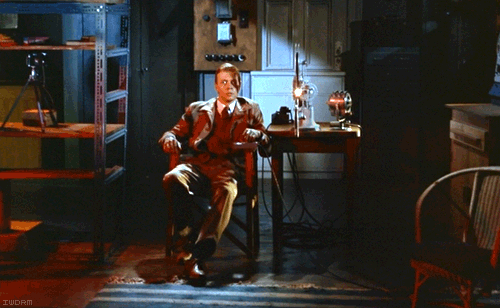
An example of what Daniel Rourke terms an "art GIF" (via)
While Stewart’s description of “the sign that generates all consequent signs” is one that erases authorship, the vernacular of frame-grab GIFs does something different. Instead of completely erasing authorship, the creation of frame-grab GIFs rearranges its tenets. Generally centered on a performer, framing the actor/actress in a context removed from the narrative flow of their source media. With their behavior on display, they carry a kind of performative authorial focus within the GIF. While the GIF is not by them, it is of them.
While GIFs may originate as souvenirs of viewership, they quickly begin to perform a different function. As Steyerl emphasizes, the labor of the frame-grab GIF comes from a place of postproduction. Stewart's watching paradigm is further revised by the level of interactivity and manipulation that emerges as an extension of traditional spectatorship. Capturing, regurgitating, looping, and distributing become regularized postproduction activities. “Collective postproduction,” Steyerl has written, “Generates not only composite bodies but composite works.”[6] As GIFs engage in their own mobility, they begin to articulate in different ways.
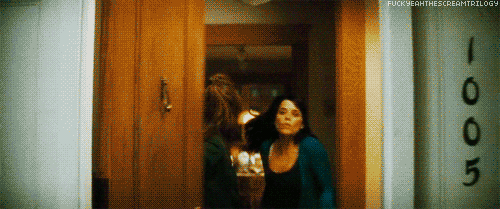
The potential of GIFability is already expected by producers of media, like Dan Harmon, who see it as a way to appease their audiences. Because in a sense, no work is complete until it has been GIFed. The GIF allows for an almost seamless level of pure circulation, especially the frame-grab GIF, which is so small as to be negligible. And if something can become a platform for a GIF, it can become a platform for its own movement, metonymically, across the Internet. This sentiment holds within it the hope that despite the decontextualization of the frame-grab GIF, it will retain at least a trace of its origin. More so, it is a hope that they carry their context with them, and become badges of pop culture connoisseurship for people looking to share their tastes.
While producers may hope that post-producers will create GIFs that, when seen, will encourage them to seek out the surrounding media. Given the fragment, one will wish to complete it. When fragmented into a frame-grab GIF, is what remains a piece of a puzzle—an incomplete remainder that needs to fit back into its linear narrative—or is it a new, seditious totality? The fragment, as understood within Romanticism, is experienced like a ruin: an irreconcilable trace of pastness within the modern world. Like the ruin, the origin of the fragment is unattainable: to be understood, it must be recontextualized.
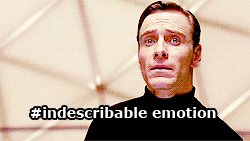
The creation of a new totality within the GIF ensures its dexterity throughout variable recontextualizations: the many ways in which the contingency of fragmentary meaning and context are tested as GIFs are used as responses, expressions, and illustrations. Their existence as a fragment doesn’t serve as a preamble to the restoration of the whole: it perpetuates a continuation of the fragmentary, as emphasized by its endless looping, its pure existence for its own moment without a need to desire to belong to another stream of narrative. As Steyerl has articulated, the supplement of postproduction overtakes its object: “Postproduction has begun to take over production wholesale.”[7] With the dispersion of the frame-grab GIF, the fragmentation surpasses its place of origin. The frame-grab GIF becomes the locus of meaning, the creation of an Internet vernacular utilizing our visual literacy.
Language carries the weight of idioms derived from once-routine activities. GIFs form an idiomatic language rooted in a communal experience not of labor or action but spectatorship and postproduction. “An ocean of viral videos turned into a self-serving visual language, looping back on itself ad-infinitum.”[8] The degrees of our literacy expand as well: we create GIFs combining GIFs, and they circulate and articulate as well.
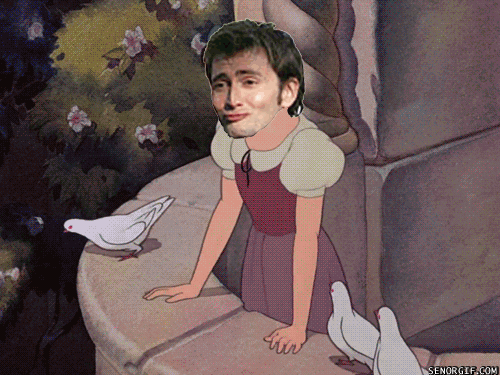
A mash-up GIF
Describing a contemporary iteration of Paul Klee’s Angelus Novus “inflated and replicated on a giant balloon inside an artificial entertainment world,”[9] Steyerl observes that this Angelus Novus has no forward movement: “It looks down on a paradise without sin and without history, in which the future has been replaced by the promise of temporary upward mobility. The horizon loops. An angel becomes drone; divine violence divested into killing time.”[10] Instead of the detritus of history, this angel witnesses an already decided state of historicity. The looping horizon could be a future deprived of history, but this perpetual looping as a property of the GIF indicates something else. The creation and collision of GIFs offers a potentially different implication for the looping horizon: the possibility of communication. Benjamin cast Klee’s Angelus Novus as a witness to the debris, or fragments, of history. A divine being, what for us constitutes history is to him only the perpetual accumulation of wreckage. Despite the destruction—and the angel’s desire to “make whole what has been smashed”[11]—he is propelled ceaselessly forward by a violent storm. Now, perhaps trapped before a looping horizon, we promote an inverted relationship of understanding: presented with supposedly whole media artifacts, we deconstruct and disperse them, wreck them and from the rubble construct a new lexicon of associations and meanings.
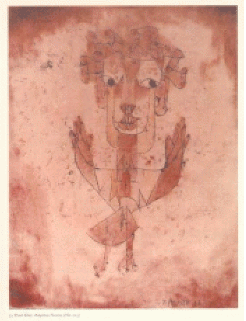
Angelus Novus GIF by Garrett Rosenblum © Garrett, Inc. 2012
[1] http://www.digitalspy.com/tv/interviews/a349824/community-dan-harmon-qa-our-fans-influence-the-show.html
[2] Daniel Rourke. “The Doctrine of the Similar (GIF GIF GIF).” http://machinemachine.net/text/ideas/the-doctrine-of-the-similar-GIF-GIF-GIF
[3] Susan Stewart. On Longing: Narratives of the Miniature, the Gigantic, the Souvenir, the Collection. Durham: Duke University Press, 1996 (1993). 11.
[4] http://machinemachine.net/text/ideas/the-doctrine-of-the-similar-GIF-GIF-GIF
[5] Hito Steyerl. “In Defense of the Poor Image.” http://www.e-flux.com/journal/in-defense-of-the-poor-image/
[6] Hito Steyerl. “Cut! Reproduction and Recombination.” In The Wretched of the Screen. Sternberg Press, 2012. 176-190. 187.
[7] Ibid. 182.
[8] http://machinemachine.net/text/ideas/the-doctrine-of-the-similar-GIF-GIF-GIF
[9] “Cut! Reproduction and Recombination.” 185. Emphasis mine.
[10] Ibid. 186. Divine violence divested into killing time, I think, has two meanings: one of course that the Benjaminian notion of divine violence has been displaced into the perpetual awareness and murderous potential of the drone. Second, though, there is a sense in which people, perpetually postproducing, become drones just “killing time.”
[11] Walter Benjamin. “Theses on the Philosophy of History.” In Illuminations. Trans. Harry Zohn. Ed. Hannah Arendt. New York: Schlocken Books, 2007. 253-264. 257.